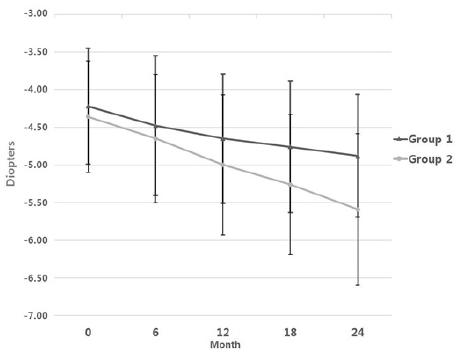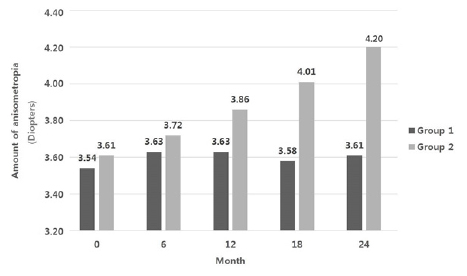J Korean Ophthalmol Soc.
2018 Feb;59(2):164-168. 10.3341/jkos.2018.59.2.164.
Myopia Progression of Full Correction and Undercorrection with Myopic Anisometropia
- Affiliations
-
- 1Department of Ophthalmology, Gyeongsang National University College of Medicine, Jinju, Korea. yjm@gnu.ac.kr
- 2The Glory Eye Clinic, Changwon, Korea.
- 3Gyeongsang Institute of Health Science, Gyeongsang National University, Jinju, Korea.
- KMID: 2403810
- DOI: http://doi.org/10.3341/jkos.2018.59.2.164
Abstract
- PURPOSE
To investigate the change of refractive error between the full-correction and under-correction treatment groups of myopic anisometropic patients.
METHODS
This study included 36 patients who had no amblyopia with myopic anisometropia > 3.00 diopters (D) and less than 6.00 D using the cycloplegic refraction test. The patients were divided into two groups involving the full-correction of both eyes (group 1) or full-correction on the less myopic eye and under-correction with −0.50 D of the more myopic eye (group 2). We monitored refractive changes every 6 months for 24 months.
RESULTS
At the first visit, the mean refractive error of the less myopic eye was −0.68 ± 0.54 D and that of the more myopic eye was −4.22 ± 0.77 D in group 1. The mean refractive error of the less myopic eye was −0.75 ± 0.58 D and that of the more myopic eye was −4.36 ± 0.73 D in group 2. There was no significant difference between the groups (p = 0.713 and p = 0.585, respectively). At 24 months, the mean refractive errors of group 1 were −1.27 ± 0.54 D and −4.88 ± 0.81 D, respectively, and that of group 2 were 1.38 ± 0.54 D and −5.59 ± 1.01 D, respectively. The mean refractive error of the less myopic eyes showed no significant difference between both groups (p = 0.555), but that of the more myopic eyes was significantly different (p = 0.027). Between both groups, the degree of anisometropia at 24 months was 3.61 ± 0.60 in group 1 and 4.20 ± 0.86 in group 2. Group 2 showed a significant difference and more severe anisometropic changes (p = 0.022).
CONCLUSIONS
Full correction of myopic anisometropia without amblyopia is a better method for reducing the progression of anisometropia.
Figure
Cited by 1 articles
-
Relationship between Dominant Eye and Refractive Error in Myopic Anisometropia
Seung-Ki Lee, Sungjin Kim, In Jeong Lyu
J Korean Ophthalmol Soc. 2019;60(5):470-473. doi: 10.3341/jkos.2019.60.5.470.
Reference
-
1. Wojciechowski R. Nature and nurture: the complex genetics of myopia and refractive error. Clin Genet. 2011; 79:301–320.
Article2. Lin LL, Shih YF, Hsiao CK, Chen CJ. Prevalence of myopia in Taiwanese schoolchildren: 1983 to 2000. Ann Acad Med Singapore. 2004; 33:27–33.3. He M, Zeng J, Liu Y, et al. Refractive error and visual impairment in urban children in southern china. Invest Ophthalmol Vis Sci. 2004; 45:793–799.
Article4. Lyu IJ, Kim MH, Baek SY, et al. The association between menarche and myopia: findings from the Korean National Health and Nutrition Examination, 2008-2012. Invest Ophthalmol Vis Sci. 2015; 56:4712–4718.
Article5. Chia A, Chua WH, Cheung YB, et al. Atropine for the treatment of childhood myopia: safety and efficacy of 0.5%, 0.1%, and 0.01% doses (Atropine for the Treatment of Myopia 2). Ophthalmology. 2012; 119:347–354.
Article6. Cho P, Cheung SW. Retardation of Myopia in Orthokeratology (ROMIO) study: a 2-Year randomized clinical trial. Invest Ophthalmol Vis Sci. 2012; 53:7077–7085.
Article7. Vasudevan B, Esposito C, Peterson C, et al. Under-correction of human myopia--is it myopigenic?: a retrospective analysis of clinical refraction data. J Optom. 2014; 7:147–152.8. Guggenheim JA, Northstone K, McMahon G, et al. Time outdoors and physical activity as predictors of incident myopia in childhood: a prospective cohort study. Invest Ophthalmol Vis Sci. 2012; 53:2856–2865.
Article9. Ip JM, Saw SM, Rose KA, et al. Role of near work in myopia: findings in a sample of Australian school children. Invest Ophthalmol Vis Sci. 2008; 49:2903–2910.
Article10. Roberts CJ, Adams GG. Contact lenses in the management of high anisometropic amblyopia. Eye (Lond). 2002; 16:577–579.
Article11. Hung GK, Ciuffreda KJ. Quantitative analysis of the effect of near lens addition on accommodation and myopigenesis. Curr Eye Res. 2000; 20:293–312.
Article12. Jiang BC, Bussa S, Tea YC, Seger K. Optimal dioptric value of near addition lenses intended to slow myopic progression. Optom Vis Sci. 2008; 85:1100–1105.
Article13. Chung K, Mohidin N, O'Leary DJ. Undercorrection of myopia enhances rather than inhibits myopia progression. Vision Res. 2002; 42:2555–2559.
Article14. Adler D, Millodot M. The possible effect of undercorrection on myopic progression in children. Clin Exp Optom. 2006; 89:315–321.
Article15. Deng L, Gwiazda JE. Anisometropia in children from infancy to 15 years. Invest Ophthalmol Vis Sci. 2012; 53:3782–3787.
Article16. Pärssinen O. Anisometropia and changes in anisometropia in school myopia. Optom Vis Sci. 1990; 67:256–259.17. Tong L, Chan YH, Gazzard G, et al. Longitudinal study of anisometropia in Singaporean school children. Invest Ophthalmol Vis Sci. 2006; 47:3247–3252.
Article18. Yamashita T, Watanabe S, Ohba N. A longitudinal study of cycloplegic refraction in a cohort of 350 Japanese schoolchildren. Anisometropia. Ophthalmic Physiol Opt. 1999; 19:30–33.
Article19. Pärssinen O, Kauppinen M. Anisometropia of spherical equivalent andastigmatism among myopes: a 23-year follow-up study of prevalence and changes from childhood to adulthood. Acta Ophthalmol. 2017; 95:518–524.



